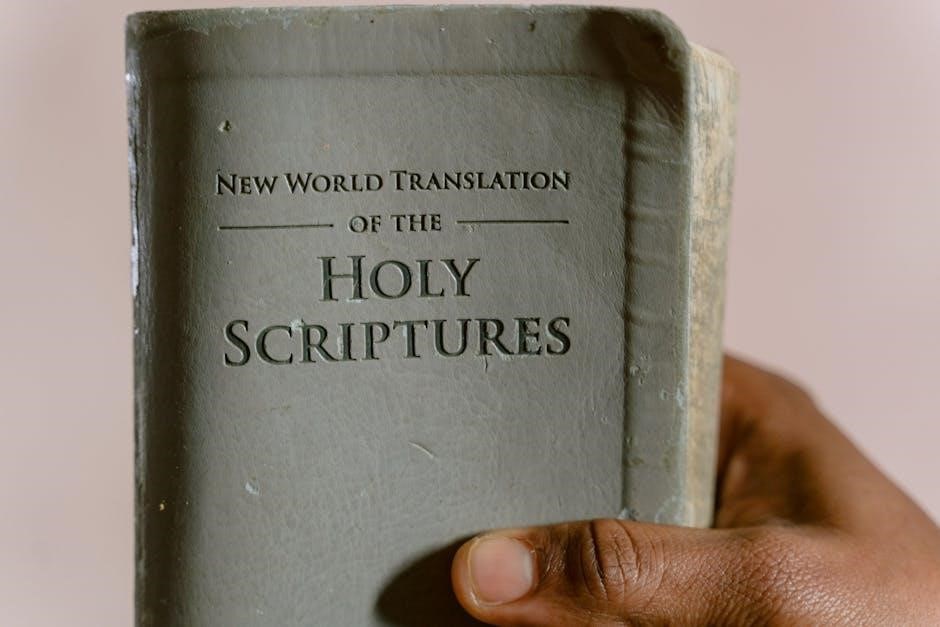The Bible Code, popularized by Michael Drosnin’s 1997 book, introduces the concept of hidden messages within the Hebrew Bible’s text․ These messages, encoded using Equidistant Letter Sequences (ELS), allegedly predict future events and reveal divine secrets․ The book sparked widespread interest and debate, blending ancient scripture with modern cryptography․
1․1 Overview of the Bible Code Concept
The Bible Code concept suggests hidden messages encoded within the Hebrew text of the Bible using Equidistant Letter Sequences (ELS)․ Popularized by Michael Drosnin’s book, it claims these codes predict events like assassinations and scientific discoveries․ The idea proposes that the Bible contains a layered, encrypted structure revealing future occurrences, sparking debate about its validity and significance․ This concept blends ancient religious texts with modern cryptography, intriguing both believers and skeptics alike․
1․2 Historical Background of the Bible Code
The concept of a hidden code in the Bible dates back centuries, with ancient scholars exploring patterns and codes within the text․ The modern idea gained traction in the 20th century when Israeli mathematicians discovered Equidistant Letter Sequences (ELS)․ This method, popularized in the 1990s, claimed to reveal hidden messages․ Michael Drosnin’s 1997 book, The Bible Code, brought the concept to the mainstream, sparking global interest and debate․ The historical roots of the Bible Code lie in ancient textual analysis, evolving into a modern, statistically driven phenomenon․
Author and Background
Michael Drosnin, a journalist and author, is known for uncovering hidden codes in the Bible․ His books, like The Bible Code, have sparked prophecy debates․
2․1 Michael Drosnin: The Author Behind the Bible Code
Michael Drosnin, a renowned journalist and author, gained fame for his book The Bible Code, which explores hidden messages in the Hebrew Bible․ With a background in investigative journalism, Drosnin became fascinated by the concept of Equidistant Letter Sequences (ELS) and their potential to uncover prophetic truths․ His work, first published in 1997, sparked global interest and debate, blending ancient religious texts with modern cryptography․ Drosnin’s approach, while controversial, has been praised for its originality and ability to intrigue both religious and secular audiences․
2․2 Drosnin’s Journey in Discovering the Bible Code
Michael Drosnin’s journey began with his 1994 visit to Israel, where he encountered the work of Israeli mathematicians exploring hidden codes in the Hebrew Bible․ Intrigued, he delved into the Equidistant Letter Sequences (ELS) method, uncovering names and events encoded within the text․ His research led to the publication of The Bible Code in 1997, which detailed his findings, including predictions of global events․ Drosnin’s work was both celebrated and criticized, but his dedication to unraveling the Bible’s secrets left a lasting impact on both religious and scientific communities․

The Science Behind the Bible Code
The Bible Code relies on the Equidistant Letter Sequences (ELS) method, where letters are selected at equal intervals in the Hebrew text to reveal hidden messages and codes․
3․1 Equidistant Letter Sequences (ELS) Method
The Equidistant Letter Sequences (ELS) method is a cryptographic technique used to uncover hidden messages in texts․ By selecting letters at consistent intervals, the Bible Code reveals encoded information․ For instance, setting an interval of 4, every fourth letter forms a hidden word․ This method, applied to the Hebrew Bible, supposedly uncovers prophecies and names, such as “Yitzhak Rabin” with an interval of 4,772․ The ELS method, central to Michael Drosnin’s book, has been both praised and criticized, sparking debates about its validity and significance․
3․2 Examples of Predictions and Codes in the Bible
The Bible Code reveals startling examples of encoded predictions, such as the assassination of Israeli Prime Minister Yitzhak Rabin and the name “Hillary Clinton․” These messages, extracted using the ELS method, appear at specific intervals within the Hebrew text․ For instance, the name “Yitzhak Rabin” was found with an interval of 4,772, while references to nuclear weapons and the year 2012 also surfaced․ These discoveries, though controversial, have captivated readers, suggesting the Bible contains hidden prophecies about world events and modern figures, sparking both amazement and skepticism․

Key Predictions and Discoveries
The Bible Code reveals predictions like the assassination of Yitzhak Rabin and references to nuclear weapons, sparking debates about its prophetic accuracy and divine origins․
4․1 Predictions About World Events
The Bible Code contains startling predictions about global events, including the assassination of Yitzhak Rabin and warnings of nuclear threats․ These hidden messages, decoded using Equidistant Letter Sequences, suggest ancient texts foretell modern crises․ Drosnin’s research highlights how specific events, like political upheavals and natural disasters, are embedded within the Hebrew Bible․ Critics debate the validity of these findings, but the codes’ alignment with historical events sparks fascination and skepticism alike, challenging perceptions of prophecy and divine intervention in human affairs․
4․2 The Code’s Relevance to Modern Times
The Bible Code’s relevance to modern times lies in its perceived ability to decode future events and global crises․ From predicting political upheavals to exploring the end of days, the code captivates audiences by linking ancient texts to contemporary issues․ Its influence extends beyond religion, sparking debates in science, media, and popular culture․ The code’s alleged predictions about nuclear threats and global disasters resonate deeply, making it a focal point for discussions on prophecy and divine intervention in the 21st century, blending spirituality with modern anxieties about the future․

Criticisms and Controversies
The Bible Code faces criticism from scientists and religious scholars․ Critics argue the code lacks empirical evidence, relies on flawed statistics, and distorts the Bible’s spiritual message․
5․1 Scientific Skepticism of the Bible Code
Scientists widely criticize the Bible Code, questioning its validity and methodology․ The ELS method, while intriguing, lacks empirical verification and peer-reviewed validation․ Critics argue that the vast number of possible combinations in the Hebrew text makes “hidden messages” statistically inevitable․ Mathematicians like Dr․ Barry Simon have challenged the probability claims, stating that similar patterns can emerge in any sufficiently long text․ Without rigorous, reproducible testing, the scientific community dismisses the code as a pseudoscience, emphasizing that untestable claims lack credibility in the realm of objective inquiry․
5․2 Religious Objections to the Bible Code
Many religious leaders oppose the Bible Code, viewing it as a misuse of sacred texts․ They argue that the Hebrew Bible’s purpose is spiritual guidance, not a cryptic puzzle․ Some claim that seeking hidden codes distracts from the text’s moral and theological teachings․ Additionally, religious scholars caution against interpreting ancient scriptures through modern cryptographic methods, asserting that such approaches lack historical context․ They emphasize faith and traditional interpretation over speculative claims of predictive codes, warning against reducing the Bible to a tool for fortune-telling rather than a source of divine wisdom and ethical instruction․

The Bible Code in Popular Culture
The Bible Code gained significant media attention, inspiring TV documentaries and a planned film adaptation․ Its intriguing claims sparked public debates, blending religion with modern intrigue․
6․1 The Bible Code Book’s Impact on Media
The Bible Code book by Michael Drosnin became a media sensation, sparking debates and discussions worldwide․ It inspired TV documentaries, including a Horizon special, and numerous interviews․ The book’s claims of hidden biblical codes captivated audiences, blending religion, science, and mystery․ Its popularity led to widespread coverage in newspapers, magazines, and online platforms, making it a cultural phenomenon of the late 1990s․ The book’s influence extended beyond literature, shaping public perception of biblical texts and their potential secrets․
6․2 Film Adaptations and Documentaries
The Bible Code inspired several film projects, including a planned adaptation by Relativity Media, set for release in 2012․ A TV documentary on the Horizon series explored Drosnin’s claims, examining the hidden codes and their implications․ These adaptations brought the book’s controversial ideas to a broader audience, blending intrigue and spirituality․ The film projects aimed to capture the book’s essence, sparking further debate about its predictions and the Bible’s alleged secrets․

The Book’s Structure and Content
Drosnin’s book reveals hidden codes in the Bible, using ELS to uncover predictions and historical events․ It combines ancient texts with modern cryptography, intriguing readers globally․
7․1 Key Themes in “The Bible Code” Book
The book explores hidden codes in the Bible, revealing predictions of historical events like the Holocaust and scientific discoveries․ It discusses the assassination of Yitzhak Rabin, the apocalypse, and even stock market movements․ Drosnin examines moral choices and humanity’s future, blending ancient prophecy with modern cryptography․ The text critiques traditional religion and questions the Bible’s divine nature, sparking curiosity about hidden truths and futuristic revelations․
7․2 How the Book Sparks Curiosity About the Future
Drosnin’s book ignites curiosity by linking ancient texts to future events, such as global catastrophes and scientific breakthroughs․ Predictions about the Y2K scare and the apocalypse captivate readers, blending biblical mystery with modern anxieties․ The idea of hidden codes suggesting stock market trends or the “end of days” intrigues many, prompting deeper exploration of the Bible’s secrets․ This fusion of past and future encourages readers to ponder the unknown and the potential hidden truths within ancient scripture․

Legacy and Influence
The Bible Code book left a lasting impact, inspiring debates and shaping modern views on biblical texts․ Its influence extends beyond religion, sparking interest in cryptography and hidden meanings, while challenging traditional interpretations of scripture and fostering a new wave of curiosity about ancient texts and their relevance to contemporary life․
8․1 The Bible Code’s Influence on Modern Thought
The Bible Code significantly influenced modern thought by bridging ancient religious texts with modern cryptography, sparking debates on faith, science, and prophecy․ It inspired films, documentaries, and scholarly discussions, challenging traditional views of scripture․ While some viewed it as a divine code, others saw it as a mathematical curiosity․ The book’s claims about hidden messages in the Bible prompted reevaluations of religious texts and their relevance to contemporary life, fostering a new wave of curiosity and skepticism alike․
8․2 How the Book Changed Perceptions of Biblical Texts
The Bible Code book reshaped perceptions of biblical texts by presenting them as more than sacred scripture—revealing hidden codes and prophecies․ It introduced the concept of Equidistant Letter Sequences (ELS), suggesting the Bible contains encrypted messages about future events․ This idea captivated readers, inspiring both fascination and skepticism․ Many began to view the Bible as a complex, layered document blending spirituality with cryptography․ The book’s claims sparked debates, challenging traditional interpretations and encouraging readers to explore biblical texts with a fresh, analytical perspective, blending faith and science in unexpected ways․
